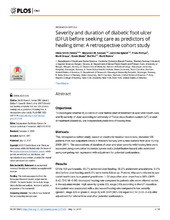| dc.contributor.author | Smith-Strøm, Hilde | en_US |
| dc.contributor.author | Iversen, Marjolein M. | en_US |
| dc.contributor.author | Igland, Jannicke | en_US |
| dc.contributor.author | Østbye, Truls | en_US |
| dc.contributor.author | Graue, Marit | en_US |
| dc.contributor.author | Skeie, Svein | en_US |
| dc.contributor.author | Wu, Bei | en_US |
| dc.contributor.author | Rokne, Berit | en_US |
| dc.date.accessioned | 2018-04-18T08:33:46Z | |
| dc.date.available | 2018-04-18T08:33:46Z | |
| dc.date.issued | 2017-05-12 | |
| dc.Published | Smith-Strøm H, Iversen M.M., Igland J, Østbye T, Graue M, Skeie S, Wu B, Rokne B. Severity and duration of diabetic foot ulcer (DFU) before seeking care as predictors of healing time: A retrospective cohort study. PLoS ONE. 2017;12(5):e0177176 | eng |
| dc.identifier.issn | 1932-6203 | |
| dc.identifier.uri | https://hdl.handle.net/1956/17623 | |
| dc.description.abstract | Objectives: To investigate whether A) duration of ulcer before start of treatment in specialist health care, and B) severity of ulcer according to University of Texas classification system (UT) at start of treatment (baseline), are independent predictors of healing time. Methods: This retrospective cohort study, based on electronic medical record data, included 105 patients from two outpatient clinics in Western Norway with a new diabetic foot ulcer during 2009–2011. The associations of duration of ulcer and ulcer severity with healing time were assessed using cumulative incidence curves and subdistribution hazard ratio estimated using competing risk regression with adjustment for potential confounders. Results: Of the 105 participants, 45.7% achieved ulcer healing, 36.2% underwent amputations, 9.5% died before ulcer healing and 8.5% were lost to follow-up. Patients who were referred to specialist health care by a general practitioner ≥ 52 days after ulcer onset had a 58% (SHR 0.42, CI 0.18–0.98) decreased healing rate compared to patients who were referred earlier, in the adjusted model. High severity (grade 2/3, stage C/D) according to the UT classification system was associated with a decreased healing rate compared to low severity (grade1, stage A/B or grade 2, stage A) with SHR (95% CI) equal to 0.14 (0.05–0.43) after adjustment for referral time and other potential confounders. Conclusion: Early detection and referral by both the patient and general practitioner are crucial for optimal foot ulcer healing. Ulcer grade and severity are also important predictors for healing time, and early screening to assess the severity and initiation of prompt treatment is important. | en_US |
| dc.language.iso | eng | eng |
| dc.publisher | PLOS | eng |
| dc.relation.ispartof | <a href="http://hdl.handle.net/1956/17624" target="_blank">Diabetic foot ulcers - predictors of healing time and aspects of telemedicine</a> | |
| dc.rights | Attribution CC BY | eng |
| dc.rights.uri | http://creativecommons.org/licenses/by/4.0 | eng |
| dc.title | Severity and duration of diabetic foot ulcer (DFU) before seeking care as predictors of healing time: A retrospective cohort study | en_US |
| dc.type | Peer reviewed | |
| dc.type | Journal article | |
| dc.date.updated | 2018-01-11T09:36:05Z | |
| dc.description.version | publishedVersion | en_US |
| dc.rights.holder | Copyright 2017 The Author(s) | |
| dc.identifier.doi | https://doi.org/10.1371/journal.pone.0177176 | |
| dc.identifier.cristin | 1485911 | |
| dc.source.journal | PLoS ONE | |
| dc.relation.project | Norges forskningsråd: 221065 | |

